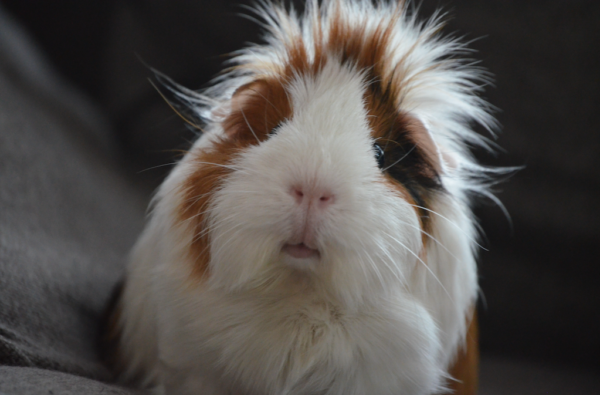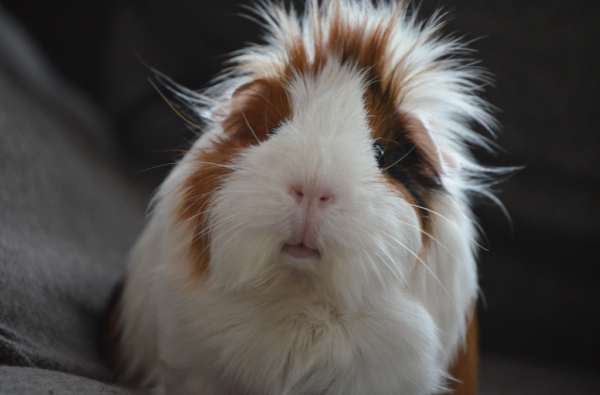 If you’re thinking about adopting a guinea pig, consider adopting one (or two!) from the Ontario SPCA. Below you can read information on everything from guinea pig nutrition, housing and more!
If you’re thinking about adopting a guinea pig, consider adopting one (or two!) from the Ontario SPCA. Below you can read information on everything from guinea pig nutrition, housing and more!
Careful consideration before adopting, including research and planning, plus plenty of love, patience and a sense of humour, will foster a strong and loving relationship that will help you discover the joy of guinea pigs, and make you friends for life!
Nutrition
A complete daily guinea pig diet consists of an unlimited supply of Timothy hay, plenty of fresh vegetables, a small amount of guinea pig pellets enriched with vitamin C, and a small portion of fruit. Guinea pigs develop individual food preferences, but some favourites include:
- Basil
- Oranges
- Turnip greens
- Bell peppers
- Cantaloupes
- Romaine lettuce
- Clover
- Broccoli
- Plums
Fresh water is required daily, and is best provided in a sipper bottle on the side of their enclosure.
Health
In addition to good nutrition, guinea pigs benefit greatly from supervised exercise in a well-secured room or yard with no access to cords, wires, stairs or open vents. Provide your pet with toys to play with and a special place to hide.
The teeth of guinea pigs constantly grow which means that chewing items are essential for their dental health. Hay, firm vegetables and non-toxic plastic or wood are great additions to their enclosures for
this purpose.
Males can be neutered by veterinarians who are very familiar with guinea pig surgery. By neutering males you can pair them up with females while preventing unwanted pregnancies. Other pairings that work well are females together and males who were raised together.
Handling
Allow your guinea pig to sniff your hand and use his favourite foods to gain his trust. Once he is comfortable, pick him up gently and slowly. Place one hand under his chest and restrain a front leg behind one finger. Use the other hand to support his hind end and back feet at all times. Guinea pigs are most comfortable when horizontal and close to your body or on your lap.
Jumping down can cause serious injury to guinea pigs, so handling them while sitting on the floor is safest. Guinea pigs should not be picked up or carried by young children, as they can easily free themselves from a child’s grasp. When returning your pet to his enclosure, he should be released directly onto the floor.
Grooming
Nail trimming should be done monthly, and can be easily demonstrated by a veterinarian. Both long and short-haired guinea pigs will also need regular brushing, with a soft baby brush.
Housing
Cages should be as large as you can accommodate. The minimum size for one guinea pig is four square feet, but seven sq. ft. is preferable. Each additional animal requires at least two sq. ft. more of floor space. The best location is in a shared part of your home where your guinea pig can be part of the family and monitored closely, out of direct sunlight and protected from family pets.
Enclosures should have solid bottoms to prevent foot injuries and a hiding place for each animal, with shredded newspaper, grass hay, aspen or hardwood shavings. Many items should be added to the cage for stimulation and to promote the health of your guinea pig, such as toys, hammocks and platforms with ramps. The list of toys is endless, but some very affordable items include:
- Tennis balls
- Paper bags stuffed with hay
- Ping pong balls
- Paper towel rolls (cut lengthwise)
- Shoeboxes
- Remove soiled shavings daily and give the enclosure a thorough cleaning each week.
Behaviour
Guinea pigs are very social animals and are happiest when they have another guinea pig companion (plus attention from their human family members). They rarely nip but can be easily startled, so only allow older children and adults to handle them.
Guinea pigs have good colour vision and great hearing, enabling them to learn to respond to specific sounds. With some patience and persistence, they can even be trained to use litter boxes!
Things to avoid
Avoid the following potential hazards to provide your pet guinea pig with a safe environment:
• Sawdust, cedar, pine and corn-cob bedding can cause illness and toxicity
• Exercise balls and running wheels are not designed for guinea pigs and can result in serious injuries
• Access to treated or painted wood
• Unsupervised time with young children, outdoors or free-roaming in the house
• Poisonous foods such as rhubarb, chocolate, potato, seeds and nuts
• Placing the cage in constant direct sunlight, a garage or a laundry room
• Providing grass, clover or dandelions from a yard treated with pesticides or fertilizers
Life span
Typically four to eight years. Some guinea pigs may live as long as 10 years!
Wild guinea pigs?!
Guinea pigs originated from South America, so they are not adapted to live outdoors in Canada. For this reason, they should never be housed outdoors or set free, as they are unlikely to survive. If you find a guinea pig running free, please contact your local Ontario SPCA Animal Centre or Affiliate Society immediately!

